Closing a sale is often easier said than done. As an ecommerce business owner, you know that sales are crucial for growth. But having multiple things on your mind around your ecommerce site, and coming out with yet another marketing strategy may be time-consuming and not always effective.
What if we would take the whole process apart and equip you with key tactics to help you implement the one and only ecommerce growth strategy you’ll need?
In this article, we’ll dive into our best practices that are already tested by our experts from the Tidio team. Correctly applied, they can help you build a better plan and uplift your sales by even 28%.
See for yourself how to boost your sales with the help of chatbots and live chat
Note:
This article is regularly updated with the newest market trends for accuracy and comprehensiveness.
Let’s dive right in—
Customers’ buying stages
All strategic plans should be based on facts. Understanding your customer’s buying processes is very important for all online store owners who want to align their strategies with the key facts about their customers.
Each customer, before buying anything, will go through a series of steps and decisions that focuses on the six-stage process, often referred to as a customer’s buying stages.
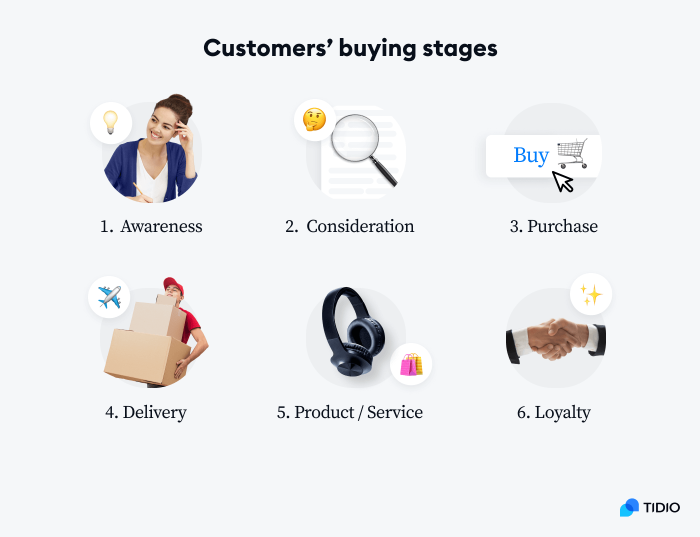
Each stage tells you about a particular goal you should aim to achieve. Let’s have a look at each of them.
Awareness
In the first stage of the customer’s buying process, the customers start to be aware of their need. It arises when the customer has a problem and requires a specific functionality or a new product to solve it. So, during this stage, ecommerce brand owners focus on making potential customers notice and visit the store.
They can do so by showing the target audience how to solve their problem with the product the ecommerce store offers. Usually, they make their business easy to find for the customer via digital marketing tactics. These include content marketing that uses SEO (search engine optimization), or social media marketing. Some big online retailers engage influencers in their marketing campaigns to spread brand awareness and attract new customers as a result.
Consideration
The consideration stage focuses on the customer’s decision to purchase the product or service. In this stage, the customer is well aware of the problem, and looking for the best options available to solve it.
In this stage, the business should focus on presenting the right product information such as reviews from existing customers, accurate product descriptions, price, warranty, after-sales service, and discounts. Anything that can convince the customer that your product is the right choice. It’s the stage when the customer decides whether to go with your offer or walk away.
Purchase
In the purchase stage, the customers know that your product or service is the right one. Congratulations! You just added new clients to your customer base. In this stage, the business should create a smooth purchasing journey and remind the customer about the reasons behind their decision.
Delivery
In this stage, the business focuses on streamlining the delivery of goods or services. Note that timely product delivery can underline the overall high-quality user experience you want to provide.
Product/Service
The goal of the Product/Service stage is to make sure the customer is using the good or service on a regular basis and is doing it with ease. Using the product increases the chance for the customer to clearly notice the product’s benefits, which may lead to the next stage—customer loyalty.
Loyalty
Customer loyalty is often described as an ongoing relationship between the business and the customer. A happy customer is often a loyal customer, so it’s essential to make sure all the stages before are influencing their decision to repeat the purchase with your business, instead of your competitors.
Now—
we’ll focus on three main areas where Tidio can help you navigate through all customers’ buying stages as a winner: customer service, reputation and sales acceleration.
Let’s start with the first one—
Eccomerce growth hacks for customer service
Potential sales increase & benefits
By following the tactics below, you can:
- Increase the conversion rate by collecting the reviews and increase your sales by even 14%
- Reverse up to 80% of negative feedback and reviews left by dissatisfied customers
In recent years, customer service has become a key department that connects customers and the business. After all, it’s the voice of your company that represents your brand, mission, vision and values. It’s only logical to make your customer service excellent.
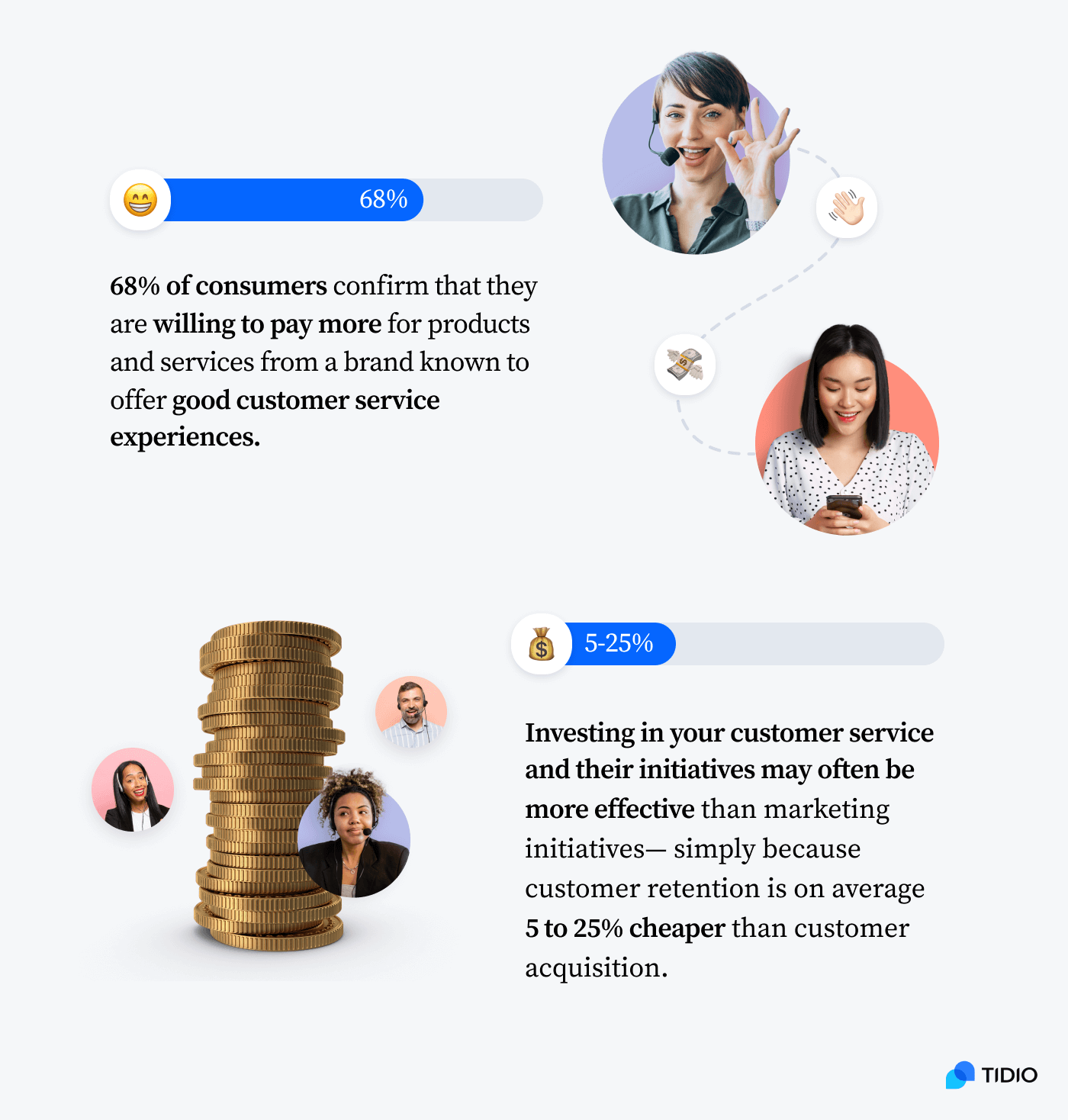
One of matters your support team should pay attention to is customer reviews. As you already know from having read about the consideration stage—the customer looks for any available source of truth about the products or services before making the final decision. Customer reviews are essential for increasing the conversion rate in your store and raising awareness of your business.
Read more: Check out our study on key add-to-cart conversion rate statistics.
There are two types of reviews:
- External reviews—focus on the reviews of your store. Users will often type in the name of your business into a Google search after adding products to the shopping cart. This directly impacts your customer purchase decision.
- Internal reviews—focus on particular product and service reviews. It’s important that you are aware of the product quality and make sure the reviews are reliable. Even a few products can generate a significant portion of revenue, so focus on increasing the number of reviews first.
It’s proven that potential customers trust brands, products, and services with at least 25 reviews. Reviews below 4.0, however, can affect and lower conversions by up to 39%.
So—how to avoid that?
With the techniques presented by our experts, you will be able to leverage the reviews to your benefit.
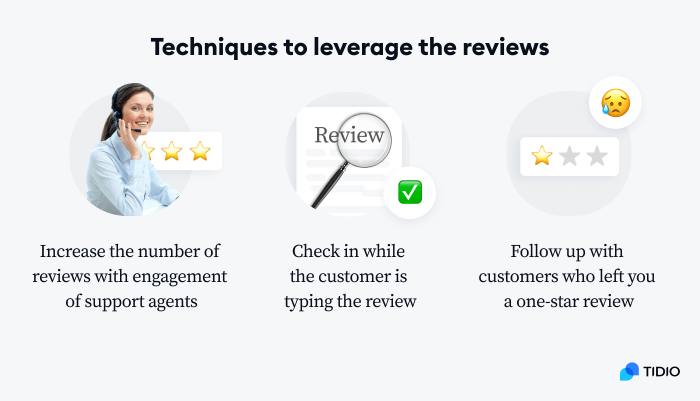
Now—let’s jump to the first technique.
Increase the number of reviews with engagement of support agents
Support agents are amazing feedback garners if you want to increase the reviews of your store, products, or services. Engage them! Sometimes, the support agents’ work can feel monotonous. Engaging the agents in a new initiative that lets you work towards a bigger, common goal can be a refreshing experience.
Success story:
One of Tidio’s users asks for reviews during chat conversations with their customers. Per 100 conversations, they are able to generate four additional reviews, giving us a 4% conversion rate. That means an average number of ecommerce conversations of about 1k provides an additional 480 reviews per year!
How to do it?
- In most products focused on ecommerce like Tidio, you can see what the person bought in the chat conversation window.
- Engage your support agents to ask for reviews of your business or products they bought. Use services such as Trustpilot, and Google reviews. You can also include a direct link to the review page to make the task easier for your customers.
- Tidio support team ensures that the conversations always meet the same standard. For this, they created a bot that launches after every chat they manage to solve.
- To motivate the agents, the support agent with the highest number of bot triggers (where there is a correlation with the number of reviews) receives a gift card once a month.
- Tidio support team asks clients for reviews at the end of a positive chat conversation. It’s best to be straightforward and friendly—people hardly say no to a small favor after a cheerful interaction.
- You can also easily set up canned responses with requests that your agents can quickly send by the end of a conversation.
| It would be great if you could rate us on Trustpilot. 🙂 This really helps us in development! |
| Would you be so kind as to leave a review on our Trustpilot page? |
| Your feedback means a lot to us; could you take a minute to rate us on Trustpilot? |
Check in while customer is typing the reviews
Customers often write negative reviews under the influence of various emotions, such as anger, which usually doesn’t make their opinion objective. That’s why we recommend asking your human support agents for help. Your agents can talk to the customer while they are writing the review to add some human touch to the processes. For technical reasons, you can only do this with reviews about your online business, but this already has significant impact on the quality of received reviews.
How to do it?
- Talk to your customers about the reviews, and be honest about how important it is for your business. Talking to a live person can help the customer feel a bit “more human” and turn a problem into a credible review.
- When Tidio’s chatbot detects that someone is writing a review and gives feedback lower than four stars, it automatically sends a message to the user: Hey, here {Agent’s Name} I just want to let you know that if you would like to chat—I am available and can help you.
Currently, this option is in beta and supports certain systems for leaving feedback—contact us to sign up for Beta versions.
Follow up with customers who left you a one-star review
One-star reviews are often an expression of not so much dissatisfaction with the product, but with the entire buying process. Reasons can vary—not having a clear manual on how to use the product, bad service, non-transparent pricing, etc. Based on Tidio’s own support team experience, listening to your customer and applying our solutions can reverse even 80% of negative reviews.
How to do it?
- Connect your ticketing system (like Tidio) or an alternate solution with feedback notifications, and react immediately when negative reviews occur.
- Have your agents reach out to the customers as soon as they notice that they left a negative review.
- Try to turn negative feedback into a positive one by using understanding tone and professional language. Notice that it’s best to send a personal message from your personal work email. Have a look at email templates for talking to customers below:
| Hi there, My name is [name]. I’m taking care of our users here at [name of your company]. I’m really sorry to see your review on [name of the website] page—I’ll do my best to help you. We’re usually able to fix issues like this one within a few minutes. [quick fix here] [optional – resolve the issue on your own] I went ahead and did [A, B, C] Please let me know if that would work for you. Again, I’m sorry for this situation, I’m looking forward to hearing from you. XYZ |
| Hello, My name is [name], I’m taking care of customers here at [name of the company]. I’m writing to you about the review you posted recently on the Shopify review page—I’d love to jump on a quick call to clear things up and show you how to set up Tidio. Would that be possible? I firmly believe Tidio is a solution for you if you want to reach out to visitors on your website. I see one of my agents already reached out to you with a solution, but I believe we can go a little further and help you personally set up your Tidio chat. Would a 30-min Zoom call work for you? Please let me know if it does – I am waiting for your response 🙂 Have a great day! |
Read more: find out more about how to handle customer complaints and deal better with angry clients.
Extraordinary and automated customer support
Potential sales increase & benefits
By following the tactics below, you can:
- Save up to $31,000 annually by automating the work of support agents
- Automate up to 47% of all conversations
On average, customer support consultants earn about $72k a year in the US. Having a great support team is crucial, yet it can become costly when you don’t balance the efforts correctly. Sometimes, the problem of overflowing inquiries can be solved not by hiring another agent, but by automating some tasks. Customer service automation is essential to optimize costs and make the work more efficient.

The most common issue with automation, however, is often the quality, or “the lack of the human touch.” With the solutions we share below, you’ll learn how to avoid cold automation and deliver remarkable quality with scalable customer support.
Automate up to 47% of customer inquiries
Now, customers are clogging live chats for support more than ever, but most of those inquiries are repetitive. And if a problem is repetitive, you can find a way to automate that inquiry with Tidio AI Response bots or any alternative solution.
Based on our collected data, 47% of the chat conversations includes repetitive questions and can be grouped into a few main topics:
- Shipping Policy
- Order Status
- Payment
- Refund
How to do it?
- Find a support solution that supports NLP bots (recognizing the context of statements), such as Tidio AI Response Bots. We know that people are irreplaceable, but even the most productive customer support team will appreciate the help of chatbots.
- Most of the NLP bots allow you to fill in the data, so they can detect what your user is asking you about. Here, you usually need at least 10-15 examples of queries. However, some solutions, like Tidio, also offer ready-to-use templates with data pre-sets from overtrained neural networks.
By automating the work of each support agent, you can save up to $31,000 annually while delivering the same or better quality.
Ecommerce sales growth acceleration
Potential sales increase & benefits
By following the tactics below, you can:
- Increase the conversion rate and increase your sales by even 15% by adding a cart booster and reducing the abandoned cart rate
The rapid growth of the ecommerce market in recent years drastically shifted the marketing cost a business needs to spend to be noticed. The costs have nearly doubled, which means you’re paying way more for each visit your user makes.
If you don’t want to lose more money on your marketing, you must focus on increasing your conversion rate. According to our calculations, these few tactics we present below can increase your sales even as much as 10%.
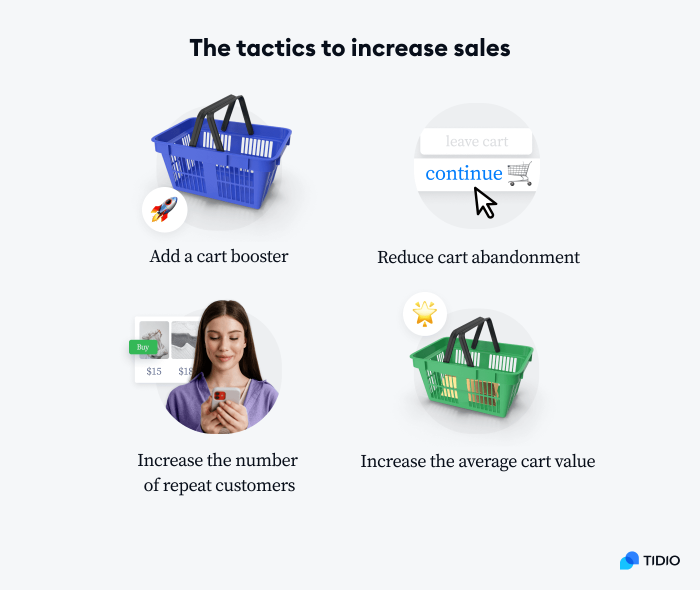
Add a cart booster
On average, customers abandon 69% of online carts. That’s why the shopping cart page is the key moment for the whole buying process. To avoid reacting when it’s too late, offer your customer a discount when they are on the shopping cart page.
Each 1% increase of conversation can generate for you 3% uplift in your sales. Assuming that you will be able to reduce abandoned cart ratio by 5%, it will give you 16% of your sales uplift.
How to do it?
- Offer a discount code to each user who visits the shopping cart page—the bigger it is, the greater the chance that the user will stay and finish the purchase.
- You can also offer a discount by displaying a banner at the top of the page or by using a chatbot that will send a promo code while the customer is on your customer’s page.
We advise against sending the codes through popup. This increase the chance of user closing the popup without copying the discount code and leaving.
Reduce cart abandonment
Abandoned shopping carts have become a legend in the ecommerce industry. More than 3x as many people abandon shopping carts than make an actual purchase, so every 1% reduction in the abandoned cart rate is an additional 3x to conversions.
You can find many email marketing systems like Klaviyo or Tidio that offer abandoned shopping carts tools such as emails and chatbots. Here we would like to focus on the situation where the user has not yet provided you with any data because this is the most common scenario that’s still a little mysterious for the business owners.
How to do it?
- Use tools that don’t require contact information when the customer is on-site, like popups or Live Chat + Chatbots combination.
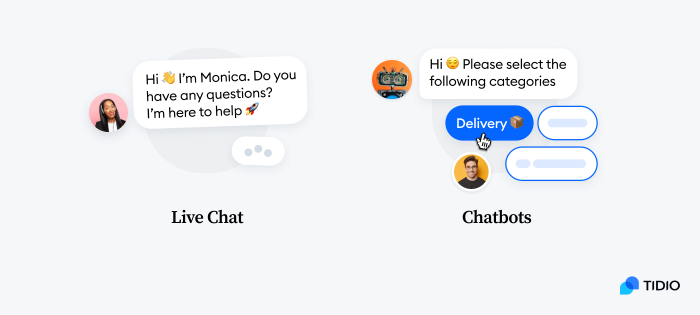
- Use Google Ads with dynamic ads, or Facebook remarketing to reach customers when they are already off your product pages. Using tools such as Google Analytics will allow you to create extensive remarketing lists.

Read more: See how to save abandoned carts with chatbots or discover the best subject lines for emails to save abandoned carts.
Increase the number of repeat customers
On average, 28% of customers repeat purchases from the same brand. Of course, this percentage vary depending on the industry and products—from 26% who repurchase cosmetics, to high-performance pet products, where it’s as high as 32%. Check where your results lay in the industry.
Moreover, shoppers often remind themselves that they forgot to add specific products to their shopping cart immediately after the purchase. Because the customers are more willing to pay and buy another product right after the previous purchase than later—it’s a good practice to suggest and recommend some products right after the purchase was made. With each passing day from the purchase, the friction of reopening the order gets higher, and customers may decide not to repurchase the product.
But—
There are some techniques to avoid it.
How to do it?
- Right after purchase, keep in contact with your customers. You can do it with email, or live chat. Live chat can be considered more effective since the user is already on the website.
- To address the problem of forgetting to add the products to the cart, you can show the customers your best-selling products with a product recommendation engine or a chatbot. Another way is to encourage the customer to add additional product to their cart at no additional cost, once it’s done within 30 minutes.
- If your stores don’t give customers an option to reopen their order to add some additional items before the shipment, you can always offer a discount code for free shipping for their next purchase.
Increase your average cart value
An average shopping cart value is a fundamental metric that translates into total sales. During your customers’ shopping experience, you need to ensure your customers complete the order and fully enjoy the overall store experience.
In the modern ecommerce market, the costs are recouped on the first purchase. However, you make more money on the returning customers. With techniques listed below, you will learn how you can increase the returning sales.
How to do it?
- First of all, do an in-depth research on products that are frequently sold together. Try to get into the shoes of your customers. For example, if you buy a TV, there is a good chance you will also buy an HDMI cable.
- If you don’t have enough data, you can find out what products to recommend by manually reviewing the best-selling products and what often sells with them.
- With the help of tools like Tidio, you can set up a bot that recommends matching products right after adding specific products to the cart.
- If you have more traffic, you can use tools such as Tidio (currently only for Plus plans) or Wiser, where products are recommended automatically after adding to the cart.
Ecommerce growth strategy: key takeaways
We know that’s been a lot of information, so let’s summarize the essential aspects.
Sales are crucial for each business’s growth, so it’s important to approach them with a strategic plan based on some facts from the ecommerce market:
- Customer retention is, on average, 5 to 25 cheaper than customer acquisition
- Engage your support team to increase the number of reviews from your customers
- Be honest with your customers about how important the reviews are for you. In the end, we are all humans
- Don’t leave the bad reviews hanging! When you see bad reviews left by your customer, try to reach them and ask what caused this opinion and how you can fix it
- Around 47% of all conversations are repetitive and can be automated with the help of AI bots such as Tidio AI Response Bots
- Almost 3/4 of all customers abandon their carts before the purchase. Strategic tactics like shopping discounts can help reduce the abandon cart rate and uplift your sales
- Only 1/4 of customers repurchase products from the same brand, so you need to use some strategic moves, such as post-purchase emails, recommended products list, etc., to increase the chances of returning customers
- In the modern ecommerce market, you make more money on returning customers. That’s why stepping up the first order process by offering bestselling and complementary products can increase the average cart value
Just remember that the ecommerce growth strategy changes every now and then for every shop, so don’t forget to always look for the fresh data and analyze updated reports.
We hope our playbook helped you plan your next strategic steps toward increasing your sales!

